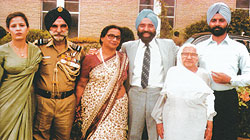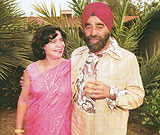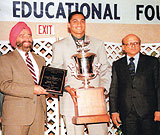|
Expert witnesses! Those who testify in courts? “No, those who give expert opinion on damaged properties in America. It is a very highly paying job. And I am qualified expert witness,” says Awtar Singh, a long-time Los Angeles resident who built the Bhakra Dam power-house in his native India in the 1950s, then came to America for a Ph.D, taught at UCLA, created the first Indian fellowship at Berkeley and is now busy building bright careers for Indian students. His altruistic mind never stops.
“So I come here to recharge myself. By golfing. By chatting with my Jewish friends. By socializing. By drinking loads of coffee,” he says, walking into the swanky El Cabellera Country Club in Los Angeles.
As we walk the walk and talk the talk, the nattily dressed Sikh suddenly points to a framed picture on the club wall. “Here is the Jewish man who created this club. He was barred from some elite club. Stung, he vowed to set up his own club. I admire his spirit. I wish Indians could emulate people like him.”
Confining the conversation to India, he says, “I cannot stop comparing India with America, though it is crud to do so. At last, they are changing, but that country should have been…” he stops short.
Then he adds: “To my mind, three things define a nation: intellect, the systems and work culture. Indians score 80 on intellect, 40 on the systems and 40 on work culture. In comparison, Americans score 60 on intellect, 80 on systems and 80 on work culture. Indians are smarter yet poor because they have poor systems and a poor work culture. On the other hand, Americans are not as smart, yet rich because they have a better system and a better work culture. Americans put in sustained hard work for eight hours. Unlike Europeans, they don’t take four-month vacations.” After a pause, he resumes, “It all comes down to the systems and work ethics. Look at these equations. Indian intellect+Indian system+Indian work culture = 80+40+40. American intellect+ American system+ American work culture = 60+80+80. Change the word American with Indian in the first equation, and you get this equation: Indian Intellect+American system+American work culture= 80+80+80=240. Which means a bright Indian kid coming to the US has a great edge over the Americans. Indian kids are a premium now. When I came, there was resistance. Now they are looking for Indian kids. Today, Indians and Jews are the most sought-after workers. America has shifted the emphasis. There is no discrimination. If one feels so, it is one’s own fault. I wish more and more bright Indian kids to be in this system.” Indeed, putting bright Indian kids in the American system is this man’s mission.

WE ARE ONE HAPPY FAMILY:Awtar Singh with his mother, brother Air Marshal I.S. Chhabra (second from left) and his wife Jagdish. At extreme right is Chhabra’s son Sherri. Sherri’s wife Yamini is at extreme left
|

Dr Awtar Singh With his late wife Teji Singh
|

Giving an award to a high school graduate at the Indian American Heritage Foundation function in Los Angeles |
Towards this end, this Los Angeles-based soil geologist has created a fellowship worth more than $400,000 at the University of California, Berkeley, for the civil engineering topper from his alma mater, Punjab Engineering College, and a scholarship at Colorado University for students of Indian origin.
“My aim is to put the best Indian student in the best university in the world to become the best in the world. I have been here for —like—40 years. No bar to excellence. The sky is the limit. The color of skin, religion, background… nothing matters. That’s why I have created this fellowship at Berkeley and am happy to see these bright boys and girls passing out and landing top jobs,” he beams.
Walking slowly on the green, Awtar Singh continues, “The idea of a fellowship was born after my wife, Teji, suddenly died in 1997. she was a teacher at a Montessori and very fond of children. She had heavy infection in the knee and was prescribed antibiotics. They had to give her intravenous injections every day. She was in hospital for a week… the infection was down. She was ready to go home so that she could give injections herself. But when they were installing ‘center line’, they punctured a blood vessel. She bled without the doctors knowing it and died on the table. I was not there. When I called them, they said they couldn’t save her. I was devastated. It was so painful.”
He continues, “We were such a happy family. She had invited older relatives to a cruise at personal expense. But she died before that. We had a joint will – that if we both die at the same time where the money will go.
“To ease my pain, I quickly went about implementing the will. As she had wished, I distributed money to a dozen relatives and friends. She died in March, and when her birthday (October 2) came, I had distributed the checks. But I was still feeling very uneasy. I felt I had to do something more to ease this pain.
“There were quite a few options. First I thought of setting up a chair at University of California at Berkeley or Colorado where I had studied. Another option was to pay for medical research facilities. In the end, the options narrowed down to helping bright Indian students with a fellowship at Berkeley. Apart from the fellowship, I gave $100,000 to Colorado University to create a scholarship worth $500 a month for a student of Indian origin. Then Colorado has an earn-and-learn programme under which they pay students (who work on the campus) $5 an hour. I add $5 from my pocket. So a student gets $10 an hour. This is in addition to the earlier endowment.”
His help does not stop with monetary assistance.
Once a week, Awtar Singh coaches Indian students for the Standard Admission Test (SAT). Many have passed this test and joined the University of California in Los Angeles or Berkeley, Stanford University and other major universities.
His face brightens up when he narrates how an MBA student had just landed a $150,000 job. “It feels nice to know that these boys and girls are doing so well. Teji and I had no children. In her memory, I have devoted myself to helping children. I mean grown-up boys and girls. They have done very well and got great jobs. They always stay in touch and come to have brunch with me on my birthday on January 18. Each year, I invite my sponsored students at Berkeley for lunch. I also sponsor Indian Heritage Awards for bright Indian students,” he says.
To commemorate Teji’s love for children, he traveled in December 2004 to her alma mater, Kinnaird College in Lahore, to donate Rs 10,000,000 for student welfare. Reciprocating the gesture, the college dedicated a computer lab to Teji and erected a plaque in her name. As he walks out of the club, Awtar Singh says, “This club is dominated by Jews. They are a very charity-minded kind-hearted people. They donate liberally to prevent cancer. I always join them in their charitable affairs.”
And he joins them in golfing affairs too.
“Touch wood, life has been wonderful. Except for a heart attack 23 years ago. That’s why I do aerobic exercises. Up at six I go straight to YMCA three times a week for an hour-long session. Twice a week, I play golf, thrice bridge and once poker. Then comes a whole lot of socializing with club mates, Indian friends, professionals and consultants. Whatever time is left, I use for making a living,” he says half-jokingly.
Born in 1927 at Lyallpur (now Faisalabad), Awtar Singh grew up with his Muslim friends. Back then, India was in the grip of the independence movement. Like millions of fellow countrymen, the young man became patriotic and wore khadi, though his dad was a rich contractor-cum-brick kiln owner.
Then came the partition holocaust.
Those eventful times are still etched in his memory. “I had just got back home in Lyallpur from Lahore Engineering College when all hell broke loose. We thought the storm would blow away and we would stay back in Pakistan as a minority. Lyallpur remained calm even as the violence raged around it. Fearing for their safety, my maternal grandfather, Dr Kishan Singh, left for India with my mom, brother and sister. Dad and I stayed back, hoping that the violence would end. In fact, I went to witness the Pakistan flag-raising ceremony in our town. But the violence didn’t stop. On September 10, 1947, a military truck convoy came and asked us to pack off. Dad and I climbed onto it with our two-suitcase cargo. It took us three days to cross the border. We were put up in a camp at Lahore. It was filthy, stinking. From there, we reached my aunt in Amritsar. I recently went to Lyallpur to see the house where I was born. It is still intact.”
From Amritsar, the family moved to Basti Gujran in Jalandhar to rebuild their shattered lives. “We moved into a small house vacated by a Muslim family fleeing India. I still remember a piece of bread lying on the table left behind by the fleeing family.”
They started from scratch. Dad went to the city hall to get a loan and restart his contractor’s business. Within years he built a big house in Model Town.
Meanwhile, Awtar Singh and other displaced students, along with their teachers, met Indian education minister Maulana Azad who sanctioned them loans and directed the Roorkee Engineering College to accommodate them. They were given separate labs and hostels.
“Ours used to be called Punjab Engineering College, Roorkee. Life was back to normal soon. My younger brother had joined the air force. He would get Rs 200 a month as a cadet and send me Rs 100. Dad rebuilt his business and took care of (my sister) Deepi’s education.”
After getting his BE degree, the young man joined the Punjab Irrigation Department in 1951 as an assistant engineer on a salary of Rs 400. “Back then, there was a log of idealism. Nehru had just embarked on the task of nation building. Universities were coming up. Chandigarh was mooted and Bhakra planned. The prime minister went on to hire the very best architects and engineers in the world.”
Indian engineers were selected for training in America. Young Awtar Singh was in that lot.
“Though I was married, I came alone and visited various powerhouses for six months before going back to take charge of a Bhakra Dam powerhouse. For six years, we worked our backs off. By then I was an executive engineer. Chief Minister Partap Singh Kairon drove everybody hard,” he recalls.
Once Bhakra was over, most engineers left India. “Letting them go was India’s biggest mistake. They were the best brains at that time, and India should have utilized their services,” he says sadly.
Young Awtar Singh too was to leave India soon. He had a different kind of problems: he had risen too soon, too fast. “I was very young and very senior. I was wondering what to do. So I thought of going to the US – at least to show that country to my wife. So in 1962, I applied for Colorado University.”
He took two years’ leave and enrolled at Colorado. His master’s degree was over in a year and he still had a year’s leave remaining. “On the advice of my mentor at Colorado, I applied for Ph.D at Berkeley. I told him that I didn’t have the funds. However, I got research assistantship and left for Berkeley. Upon completion of my Ph.D in 1966, I joined the University of California in Los Angeles as a professor. That was the best place to be in. I have not left Los Angeles since,” he says with a smile.
With a view to commercializing his skills, he joined hands with a friend in 1972 to set up Lockwood-Singh Associates to provide specialized services in soil and geology. After 13 years, he bought out his partner and shifted focus from genetic (foundation design) to failure analysis, which basically means finding construction defects.
“I became an expert witness who performs autopsy on damaged properties. This has been my specialty since then. My clients include attorneys, insurance companies, home owners, dispute mediators and judges. They hire me to give expert opinion on damaged properties / construction defects. As an expert witness, you are usually paid two to three times more than an engineer,” he says. In 2002, Awtar Singh took a decision over which he had agonized for years: he sold his company to another public company called Failure Analysis with a “no-competition-for-four-years clause,” meaning he would not compete against them for four years. But he could work with them.
And he did work with them.
Later he regretted his decision. Why? “I took the decision to sell Lockwoo-Singh because I was getting on in years and worried about my 15-member staff in case something happened to me. But soon I realized I had made a bad decision on two counts. One, my old staff members, who were absorbed by the new company, were very unhappy and left. Two, Failure Analysis didn’t treat me well. The differences were cultural – small company versus big company. They were very impersonal. However, I stayed on just to keep myself busy.” September 2004 marked the end of his four-year agreement with Failure Analysis. And he lost no time in waving them goodbye.
“Three of my former staff at Lockwood-Singh have floated a new company called SGH Consultants and I am on board. At Lockwood-Singh, I had set up a tradition of inviting 80 to 100 people for dinner at my place. Happy days are here again. Tonight these SGH guys – my own guys – are coming once again for dinner at my place,” Awtar Singh smiles. Just a stone’s throw away from the country club sits his cozy home in the posh Encino locality in the Santa Monica mountains. Keeping him company is his neighbour Peter Marshall of Hollywood Square fame.
“We have been neighbours for more than three decades. Peter is nearing 80. But he is still a sing-and-dance guy. One day his wife asked my age. Then I asked Peter’s. I found we are of the same age. He is a great and gracious guy.”
Lowering his voice, he adds, “Life becomes a lot easier if people stay nice to each other. Finding fault is not my nature.”
Finding ‘defects’ is.
—Excerpted from Gurmukh Singh’s book California Dreams.
|